Tom Sciortino's
L E G O C R E A T I O N S
Last Updated February 2012
Discovery Series
|

|
Mars Express Mission |
|
The Mars Express mission was launched by the European Space Agency in 2003, during Mars' closest approach to Earth in millenia. It was launched on a Soyuz rocket and featured both an orbiter and a lander (the Beagle 2 lander was unfortunately lost after separation). The orbiter continues to operate to this day. The Soyuz rocket has a remarkable history spanning clear back to the beginning of the space age with the launch of the first artificial satellite by the USSR, Sputnik, back in 1957. It has since put the first dog in space, the first man in space, and the first tourist in space. This Mars Express kit includes the Soyuz launch vehicle, the Mars Express obiter with display stand, and comes complete with stickers and instructions. The Lego Discovery theme was a theme that ran in 2003 featuring famous space missions and vehicles such as the Apollo 11 lunar landing, Saturn 5 rocket, and International Space Station. I've designed this kit to have a similar scale and style to the actual Lego Discovery kits. Design notes: Well kids, if you've ever thought geometry is useless, try designing stickers to fit on curved surfaces some time. Same goes for trigonometry, for that matter. There were two challenges to this model. Getting the form right and making the stickers. One of the form problems was finding some way to fill in the gaps in those 3x6 cylinders. I tried several ways of filling them with parts untill it dawned on me that I could simply cover them with stickers. Yeah, maybe it is cheating... I used a similar cheat to turn the black 3x3x2 cone into a dark grey 3x3x2 cone (they don't exist in that color, or at least they didn't at the time--they may now, I don't know). It took an afternoon at the laundromat with my calculator and pencil, but I was able to design a sticker to solve the problem. The other form problem was the boosters. I tried several methods to get the slight angle on them and each one solved one problem and raised another. I eventually wound up using the 1x2 hinge plates and a 1x1 brick with studs all around, though there are still other ideas floating around in my head that may work better. This model, along with my Myralux, is one of the first to require me to buy parts online. I ran amok on bricklink (which is really too easy to do) and got parts for 4 different projects that have been on hold for months. Anyway, thanks go out to those sellers that made this model and others soon to come possible. It was a lot of fun and I think I'll be doing more stickers in the future... |
||
Propulsion
|
Armament
|
Designed and Built
|
VX-212
|
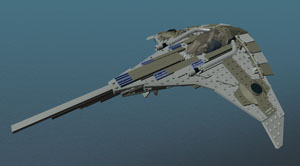
|
VX-212 Myralux |
|
The VX-212 Myralux was concieved of as a space-capable aquatic craft, perhaps piloted by an advanced species whose planet is primarily oceanic. Under water propulsion is via a magneto-dynamic syphon system (no moving parts). Water is taken in via the tubes on either side of the canopy and expelled out the nozzles in the back. It also features foldable landing gear with closing landing gear bays. Its only weaponry is an array of four harpoons mounted ventrally. Design Notes: This one's been under construction since late June, 2003, and I still consider it a work in progress (in particular, the engines and the space on top near the canopy and flags still need some polish). There are several changes in the process I used to design and build the Myralux. In the past, I've shot for just form and then fixed the colors in LDraw. That worked for simpler models, but I've found it's very difficult to build a good form when the off colors are driving me crazy. This is the first model since my Apollo fighter that I've built in the actual colors which helped a lot during the design phase. This is also my first design-from-idea since my Scythe tansport. Usually, I let the ships build themselves by putting parts together and hoping they lead me somewhere, but the idea for the general form for Myralux (the curved surfaces with a cabin set towards the back and weapons underneath) came all at once in a flash. The details such as engines, landing gear, and weapons came from experimentation. The building progress followed this pattern too; it went quickly right up to the engine design at which point everything broke down. After several experiments and a little luck, it's pretty much presentable though I'm not completely happy with it. Finally, this is my first shot at semi-studless design. The idea to make it studless came a bit late (keep in mind "studless design" was just becoming popular in 2003) and if I were going to do it over again, I probably would have made the wings from horizontal bricks instead of the standard studs-up plates. The 2x2 flags are actually mounted to Technic flexible tubing which is held in place via clip plates and clip tiles (see the yellow pieces in the ldraw model). There are some gaps in the interior where the wings would be mounted--I plan to redesign the wing mounting so they'll be a bit more sturdy while requiring less space to mount, perhaps using technic locking connectors as I did with the Apollo. For now, I haven't bothered to include the parts for the wing mounting though they're just more 1x2 hinge plates. |
||
Propulsion
|
Armament
|
Designed and Built
|
PX-38
|
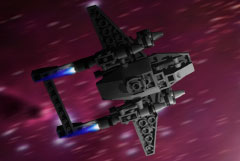
|
PX-38 Thunder Clap |
|
The PX-38 Thunder Clap is a sport craft built for people who want more than just a method of getting from point A to point B. Fast and efficient, the Thunder Clap adds fun and a touch of nostalgia to your everyday errands. The model shown here is used in air shows and has been modified to carry two low power anti-matter ejection canons, for visual effect only. Design Notes: The P-38 Lightning: the coolest looking WW2 plane in existance. How could I not make an entry for a space contest featuring this plane? Seeing as the Lightning is a classic, I couldn't help but think "Classic Space" when I got started building, hence the classic fig and the old style parts. Design issues were minor. The first was figuring out how to get landing gear on it. The results were not completely graceful and ended up making the nose asymmetrical, but I think it was worth it just to have landing gear on a model so small. The other challenge was putting the center of gravity beyond the rear gear. It eventually all worked out. The model can be built in real life, in the colors shown EXCEPT for the grey 1x2 tiles with grill pattern. I thought they existed, but aparrently they don't. Anyway, close enough. I've also recently learned how to use photoshop. Took me long enough. |
||
Propulsion
|
Armament
|
Designed and Built
|
Nork
|
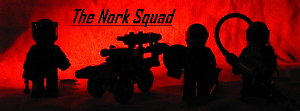
|
'Nork Squad |
|
Got a Fleebnork problem? Call the Pro's. The Nork Squad is composed of 3 highly-trained, professional Fleebnorkers whose pleasure it is to rid you of those annoying and often dangerous space pests known as Fleebnorks. The 'Nork Squad: Professional fleebnork extermination, affordable prices, and the lowest collateral damage record in the industry. Frank Christianson, aka "The FCC", is the leader of the group and he is also the only one who is not heavily armed. His expertise in xenopsychology and cutting edge tracking technologies make him the ideal man to take charge of hunting strategy. It's his business to keep up with the latest fleebnork habits and tactics, ensuring that the group stays one step ahead of this ever-more-crafty breed of space pest. At first glance, Matchbox appears to be your typical pyro. He's never denied the story of him having set the family cat's tail on fire with a magnifying glass when he was four years old, though he doesn't say much in general. He dropped out of college shortly after enrolling to follow his first love: fire. He's actually an agreeable sort and is quite slow to anger, but often his thorough enjoyment of melting things with his plasma thrower leads people to think they're best off not risking eye-contact. "Platinum" Pete Tanaka earned his master's degree in chemistry in 5 years after finishing highschool a year early and has a general habit of doing things quickly and efficiently. He earned his nickname in college for his extensive work with corrosive gases. Since then, he's taken to spelling his name Pt which has the added bonus of being faster to write. He carries an elecron pulse gun, which he calls his "Zapper," and his own concoction of a sulfuric acid spray blended with other chemical agents. He mentions a "secret blend of 11 herbs and spices" but has never clarified what that might mean. Skeeter is the fourth member of the three man team. Though he was not programmed with any kind of personality, he comes off as playful and sometimes a bit of a show-off. While often this causes Pete to spend far more maintenance time with him than he should, it's been good for publicity so no attempt has been made to correct the behavior. On-lookers always love watching a bot that enjoys its work so much. Skeeter is armed with two plasma torches, a radiation gun (which is only effective as a stunning weapon for fleebs and does no real damage), and a diamond coated high-speed saw for getting those especially crafty fleebs where they think they're safe. Design Notes Today's MOC was brought to you by the parts "Minifig Hand" and "Tap." Minifig hands are one of the smallest lego pieces, so they make for an excellent detail piece for an already small MOC. I've used them for control levers, hand holds on weapons, and just as general greeblies. The tap is the key to Skeeter's face and also came in handy with the weapons. I wouldn't say there were really any difficulties with these guys. It was all pretty much trial and error with both parts and colors untill I thought they looked cool. The bot was a fun piece of work. He's part robotic hunting dog, part swiss army knife, and all fleeb-terror. No minifigs were harmed during the making of this MOC. Except for the ones running around without hands. |
||
Propulsion
|
Armament
|
Designed and Built
|
X-89F
|
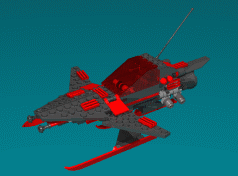
|
Raven X |
|
The Raven II, more popularly known as the "Raven X" is a custom-made high performance racing craft built in the spirit of the great Air Races of the early 20th century. Design Notes: This model is a remake of my X-89 Raven which was probably my first real MOC, built in 1988 (5th grade). The idea was to preserve the overall design but modernize the style and technique. The the wing shape, skid-style landing gear, 1x1 cones in the nose, the large engine in the tail, and the smaller thrusters behind the cockpit all made it into this new version of the ship. The large cannon on the roof had to go to allow for the canopy to open (one of the main flaws of the original design was that you had to take the model apart to get the pilot in and out). As this new design felt like a racer and not a fighter, the cannon really lost its purpose anyway. The engine mounting went through several complex variations before I finally settled on the 20 year old L bracket. Another tough spot was the mounting for the rear skid which I also ended up doing in a rather simple configuration. I'm not so happy with it, but the engine is interesting enough to distract from it, I think. The SNOT work between the nose and cabin (the heart of which is well concealed under the nose) was very difficult untill I dumped the use of a certain special piece which I intend to use in another model. Finally, the work behind the seat and above the engine mounting was difficult due to all the different things I wanted in there. The seat back, thrusters, flag, and the podracer fender all had to be mounted in one little spot, and the whole thing had to be sturdy enough to not fall apart. Perhaps the hardest part of all was nailing down the color scheme. The skis only come in red, teal, yellow, and white. I really wanted to use black and teal, but not enough other things came in teal and I also couldn't quite find a color of glass to go with it. So in the end, Red and Black is a rather uncreative color scheme, but I felt forced into it. On the other hand, the model is buildable in real life, in the colors shown. |
||
Propulsion
|
Armament
|
Designed and Built
|
Electronic Mod10026 UCS Naboo Fighter |
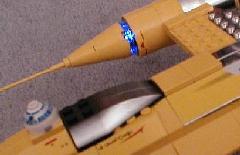
|
10026 Engine Light Mod
Technical Details |
|
Here's my electronic mod to the 10026 UCS Naboo Fighter to light up the engines and add to the realism. There is a blue LED in each of the engines wired to a 12 Hz timer chip giving a nice flickering-flame effect. The animated gif linked above gives the general idea though even on my 1.5 GHz machine it doesn't flicker nearly fast enough. 12 Hz is about perfect to make it look like a flickering flame rather than always on or flashing on and off. MODIFICATIONS TO THE MODEL:
THE CIRCUIT:
DESIGN NOTES: Blue LED's require a lot more voltage than your typical LED - anywhere from 3.6 to 4.2 V, so to get the circuit to run and leave a little room for overhead, use at least 6 Volts. This works out perfectly, as even if I could have found a way to fit three AAA batteries into the chasis (without removing the black 4x8 plate which basicly holds the whole thing together), it still would not have been enough to drive the LED's. Another option would be to run an AC adapter into it, but that would greatly hinder the swooshability. ;) If you are actually making this, be sure you pass the led/wire combo through the necessary pieces before soldering to main circuit! Using R2 as an on/off switch would have been cool, but there is a limit to how many parts I'm willing to put under the knife. The more difficult to find parts can be gotten from Mouser Electronics. For instance, I ordered the battery clip and the very small push-on push-off switch there. The LED's and other discreet components can be found at Radio Shack or any standard electronic parts store. |
||
Propulsion
|
Armament
|
Electronics Designed and Integrated
|
Sol WindIntroducing: Sam Blackjack |
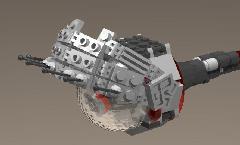
|
Sol Wind |
|
The Sol Wind is the personal vehicle of Sam Blackjack, private I. If you look closesly at the paint, you can see the original name coming through the top coat, which reads "Soul Window," but upon purchase, Sam (or "Twenty-one," as his friends sometimes call him) promptly renamed it. Commenting that "Soul Window" was a stupid name and he didn't know why in tarnation anyone would name a ship that, he has never thought twice about it. At any rate, the Sol Wind is equipped with a gravitic repulsor drive (an unusual propulsion mode for a ship of its size) and an ion engine for interstellar flight. It's not the fastest thing in the galaxy, but Sam would tell you his quickdraw makes up for that. A bit of an eccentric, Sam prefers to use projectile weapons over the more modern energy weapons. His choice: an antique Colt revolver kept in pristine condition, with the chambers loaded. In his words, "I Ain't never needed more'n 6 anyway!" And to his credit, he hasn't. The ship has two storage compartments for his hat, magnifying glass, and other tools. The gun stays in the ship. Design Notes: As with all my rendered models, this one is buildable in real life in the colors shown (unless I've missed something). The pseudo-spherical lid was rather difficult to come up with. Other than that, the design wasn't too bad. Trying to fit a minifig into something so small, yet still keep it sturdy and functional was also rather difficult. Finally, if you look at the dat file, you'll see that the scanner doesn't appear to be attatched to anything. It should swing up and down via the modern LOM martian arms (also used on SW droids). I couldn't find them in Ldraw dat form and I was too anxious to be done with the model, so you'll just have to imagine them there. |
||
Propulsion
|
Armament
|
Designed and Built
|
Ice Blaster
|
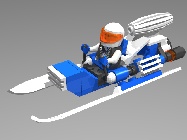
|
Ice Blaster Turbo Sled |
|
Hey kids! Do you love sledding down snow covered slopes? Do you wish you didn't have to drag the sled back up the slope in order to go again? Do you want to go faster and farther, or just beat that annoying neighbor kid? Well then, tell mom and dad about the new Ice Blaster turbo sled, from Pediaclast Industries! Built in the same colors and using the same micro-fusion engine technology as the official Ice Planet mining corps, the Ice Blaster is fun for all ages, and safe[2] too! And remember, if you like the turbo sled, you'll love Pediaclast's full line of Ice Planet toys! Be just like a real Ice Planet miner with our Ice Planet Chainsaw! Blast tunnels in your back yard with Ice Planet thermal mines![3]
[1] Ice planet miner costume and seatbelt upgrade kit sold separately. |
||
Propulsion
|
Armament
|
Designed and Built
|
BZ-33
|
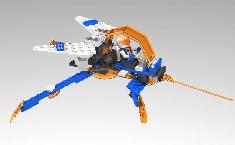
|
BZ-33 Frost Fly |
|
Natural enemies: Frost Frogs and Very Large Fly Swatters. Many have made a distinction between the Frost Fly and the so-called "Frost Flea," but they are in fact one in the same, the Flea being simply another form of the Fly. The legs are quite articulated, as are the wings, allowing this bug to resemble a house fly, a flea, or even a rhinoceros beetle. I wasn't sure if I should enter this one under IP Alternates or IP Insanity, but I've decided to go with alternates, since, well, it's an alternate. This is my first attempt at building an alternate model since my Sparrow Killer, which I don't think really counts, since it was very closely related to one of the alternates on the back of the Alienator box. Finding a way to use those skis as hinges was the most difficult part. The stock model (if you haven't guessed) was the Blizzard Barron, and after extensive remodeling, there are 5 pieces left over, and one Insectoid crossover. |
||
Propulsion
|
Armament
|
Designed and Built
|
Ice Planet
|
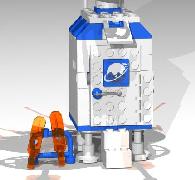
|
Ice Planet Outhouse |
|
Though the Ice Planet Outhouse is specially designed for the sub-zero temparatures common to the Ice planet, it is also equipped with many other special features not found in ordinary outhouses such as EcoGreen (R) environmentally friendly soap, a handy ski rack, an energy-efficient IR hand dryer, and biodegradable toilet paper. Oh, and don't forget everybody's favorite, the BunWarmer (R) heated toilet seat. And thanks to IP Inc's excellent customer service policies, each IP Outhouse is also equipped with the latest issue of IceAge Magazine, delivered bi-weekly. Now, what people don't know is that there is far more to this innocent looking porta-potty... Beneath this clever disguise, there is a fully equipped reconaissance station capable of decoding enemy trasmissions in real time, jamming wide band signal sources, and cooridinating offensive strikes from remote locations, thanks to its 20 GigaWatt, pan-spectral, multi-phasic satellite system (concealed cleverly on the roof top where no one would think to look). And yes, it also gets HBO. Blacktrons beware: your every communication is being monitored by IP Outhouses everywhere... |
||
Propulsion
|
Armament
|
Designed and Built
|
Polar Research Station |
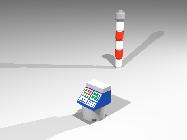
|
Polar Research Station |
|
Yup. It's definitely a pole. Better build a research station near it, just to be sure. Oh, and aparently, the Iceplanet has 3 suns. (But we didn't have to build a research station to figure that one out - That would just be silly!) |
||
Propulsion
|
Armament
|
Designed and Built
|
NX-92
|
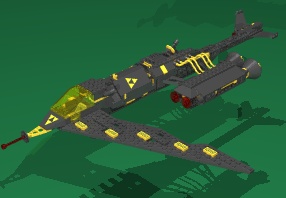
|
NX-92 Scythe |
|
"If it has to be there yesterday, it has to go by Scythe." The Scythe is meant for carrying small, important cargo from point A to point B without getting stopped in between. It has no armament to speak of, but it is equipped with the standard Blacktron cloaking system, as well as a very special engine. The Scythe is one of the only Blacktron ships with faster-than-light capabilities, making its slogan more than just exageration. Naturally, this property makes it extremely popular among smugglers. The ship's odd design is compensated by the internal anti-grav generator, which ordinarliy is used only for takeoff, landing, and minor maneuvering. In the Scythe, it performs a double roll by shifting the vessel's center of mass over to where it needs to be for stable flight. Failure of the anti-grav generator would theoretically send an unfortunate pilot to a spiraling doom, but this has never happened yet. It is also this odd design that often inspires such interesting names as "One Armed Bandit," "Fish Bone," and "SST." Design Notes: An Experiement in asymmetry, the Scythe embraces the ideas found in Renegade and takes them a step further. After I decided to build a ship with the form of a scythe, the first step was modifying the Lego group's Invader. The three modules still follow the basic Nose-Cargo-Engine pattern of the Invader, and if you look at the port side of the cargo module, you can also see another minor resemblance to Invader. This is also my first model that required some preliminary sketches. If I get around to finding a scanner, I'll put up the drawing. To make it truly Blacktron, I tried to make it very functional. This meant that it had to be modular, and no space should be wasted. In the end, I'm rather satisfied with the results. Ordinarily, I probably would not have bothered building the droid compartment or the droid, but I felt that there was just a bunch of solid Lego in the middle of the drive section that wasn't being used for anything at all. So, I used it. :) |
||
Propulsion
|
Armament
|
Designed and Built
|
V0-001A
|
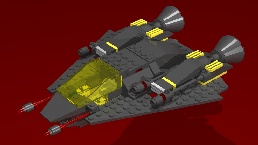
|
V0-001A Intruder |
|
Rumours of a new Blacktron fighter were confirmed when a squadron of 6 modified Invaders annihilated a Kelden class cruiser in just under 15 minutes. The new fighter, dubbed "Intruder" is fairly heavily shielded, especially for a ship it's size, and has an extreme amount of firepower. The original Invader class of starfighter had become little more than a courrier in its later years, so it was not without irony that the Blacktron starfighter division took an ailing design and transformed it into the deadly Intruder class assault vessel. The engines were kept secret from even some of the empire's highest officials, however it has fast become known that they are not the typical B class engines most midsized fighters are equipped with. While the standard Invader came with two lower power lasers (the nose mounted weapons), the Intruder is armed with four Sunburst heavy lasers, as well as a new particle beam weapon. Particle Beam weapons were abandoned long ago in favor of laser weapons due to their enormous energy requirements and physical space limitations. It was thought that for a particle beam weapon to be as powerful as a comparable laser weapon, you would need a light troop transport to carry it. It seems the Blacktron engineering corp found a solution to that problem, and most scientists speculate that the engines and the weapons system feed off of some new form of power supply. Something far more space efficient than ever used before. As Alliance scientists scramble to unlock the secrets of the Blacktron's new power source and their new particle beam technology, all cruisers have been assigned fighter escorts and all military outposts are on hightened alert... |
||
Propulsion
|
Armament
|
Designed and Built
|
T1-E
|
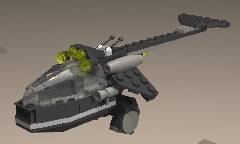
|
T1-E Skyhop |
|
This one was inspired by the movie A.I., and I've tried to make it as true to the real thing as I could. It is a small VTOL craft, originally a police vehicle in the movie. It's really just a small personal transport. It is also submersible, so it is extremely adaptable to the environment. The Skyhop is equipped with no weapons, no shielding, and minimal engines. Anti-grav was not feasable in a vessel this small at the time, however, computer controled thrust vectoring had come to near perfection, making the Skyhop almost as nimble as a modern, anti-grav model of similar size. It can land pretty much anywhere there's space for it, as it needs no runway. This model also has an array of search lamps above the canopy which come in very handy when in an under-water environment. Design Note: If this model looks slightly familiar, I started with the nose from the Star Wars B-Wing and went from there. Also, there is some odd placement of 2x2 round tiles - these are actually meant to be those convex "button" tiles found on the undersides of iceplanet ships. Either the part doesn't exist in Ldraw, or I just can't find it, so I improvised. |
||
Propulsion
|
Armament
|
Designed and Built
|
A1-F
|
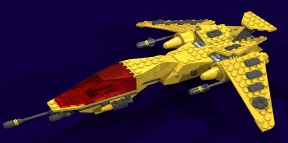
|
A1-F Apollo |
|
The A1-F Apollo is the latest fighter from the Europa Shipyards, now famous from the recent success of their Triton fighter. Heavier and slower than the Triton, the Apollo is an assault craft armed with no less than three Sunburst laser cannons. While it does not perform nearly as well as the Triton in dog fights, when it comes to attacking larger ships or ground facilities, most pilots agree that the Apollo's superior fire power is preferable over the Triton's agility. |
||
Propulsion
|
Armament
|
Designed and Built
|
MB-4
|
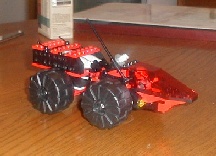
|
MB-4 Lynx II MB-4 Lynx (1994) |
|
This Vehicle was inspired by the Lynx from the video game Military Madness (for the TG-16). So far, it's the only thing I've ever designed that has wheels, as most of my work is in things that fly. I originally designed the Lynx back in 1994 or so. I've provided links to the 1994 design if you'd like to see how it's evolved. Pretty much the only things that survived the remodeling were the tail pipes. The Lynx is a small Dune Buggy armed with 2 long range surface-to-air missiles, also sometimes referred to as "HAND's". The term "HAND" can be applied to just about any high yield weapon of destruction. It first came into use when fighter pilots began writing the words "Have A Nice Day" on their warheads. The phrase soon became an acronym, and now it is common place to hear a soldier speak of his vehicle as being "armed with 2 hands". The Lynx is a light, fast ground vehicle meant to run into the field of fire, deliver its payload, and run out as fast as it came in. Typically, they are armed with either surface to surface missiles, or surface to air missiles. Lynx's play a pivitol role in knocking out enemy radar stations, allowing allied air power to safely complete its missions. |
||
Propulsion
|
Armament
|
Designed and Built
|
A3-N
|
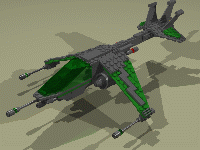
|
A3-N Triton |
|
Designed to appear both graceful and menacing, the Triton is a fast, light fighter that packs a mean punch. It is easily recognized by its three-cannon, three-tail configuration. Excellent visibility, rediculously over-powered weapons and propulsion systems, and versatility are only a few of the things that make the Triton a superior spacecraft. The nose-mounted cannon is a Sunburst, while the two wing mounted cannons are conventional heavy lasers. One of the more common variants, the A3-N/S Triton "Stealth" replaces the nose cannon with a pan-spectral scanner and is equipped with a cloaking system. The Stealth variant is used mainly for reconaissance but occasionally supports other ships in surprise assaults. It's been said that the Triton Fighter spoils men; once they fly it, they will never again fly anything less. The key to this fighter's success is its oversized engines. Though they are seldom operated at over 50% power, they are there to provide the fighter's other systems with an extended power supply. The Sunburst cannon alone could not operate with much less than the power provided by the two B class engines. As a historical note, the Triton was designed by the same corporation that built the Skyraider, hence the slight similarity between the two craft. |
||
Propulsion
|
Armament
|
Designed and Built
|
F-12A
|
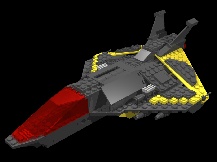
|
F-12A Hellcat FX-12 |
|
The Hell Cat was my first attempt at a transforming vehicle. The first thing I realized is that I wasn't going to be able to make it go to a robot mode, so I was content to have a simple Plane to Guardian transformation. The legs simply fold back and the arms fit inside of them. The transforming variant has a number of things wrong with it; it's not realistic (the arms go where the engines should be) and the arms are too skinny. Finally (and most importantly), it's ugly. The legs are too long and the wings are too short for plane mode to look good. The non-transforming variant fixes these problems. The F-12A Hell Cat has the engines moved up directly underneath the rear wings with air intakes under the front wings. This was slightly inspired by the pink car from F-Zero (for SNES). The Hell Cat has two hybrid in-or-out-of-atmoshpere engines. The engines operate as standard jet engines while in atmospheric flight and switch to a vented plasma mode when in space flight. Armament consists of 3 plasma missiles, one Sunburst heavy laser cannon, and two anti-matter ejection cannons. |
||
Propulsion
|
Armament
|
Designed and Built
|
KX-72
|
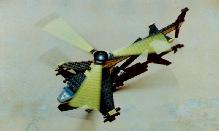
|
KX-72 Kestrel |
|
The Kestrel is a light assault helicopter armed with 4 machine guns and 2 air to air missiles. Most of the things I build are futuristic spacecraft. The Kestrel is an exception and uses only current technology. I built it during July of 98 and it was the only model I feel I actually got right the first time... ...So here I am, a year later, and I've decided I've never quite been happy with the landing gear setup. So, I redesigned it. The new landing gear is retractable and the Kestrel looks much better with the gear up. I also lengthened the rotor blades by two studs, modified the engines, and fixed a few structural problems (replacing multiple smaller pieces with single larger ones, reinforcing weak points, etc). |
||
Propulsion
|
Armament
|
Designed and Built
|
AG-25B
|
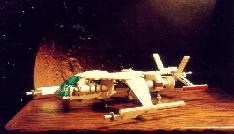
|
AG-25B Skyraider II
AG-25 Skyraider |
|
I started this one in July of 98, just before I built the Kestrel. Finally, six months later, I believe I have a final version of it ready. The wings and tail have remained the same, but the cabin and landing gear have been redesigned (repeatedly...). Among other things, the cabin looks more like a bird of prey and less like a bus. The Skyraider is the first of the next generation of air/space craft powered by matter-antimatter technology. The two cylindrical structures behind the wings can hold a combined total of 1.2 kg of antimatter--more than enough to power the craft for literally years--and can be jettisoned in an emergency. Propulsion is provided by three separate systems. The main engines are standard jet engines and are located behind the cabin. When the Skyraider leaves the atmosphere, propulsion is provided by the secondary system, the venting of plasma from the rear of the craft. This is terribly less efficient than the jet engines, but necessary if there is no oxygen present. Plasma venting can be used at any time, in or out of the atmosphere for a silent operating mode. The final propulsion system is based on a small directional antigravity generator located on the underside of the craft, between the antimatter containment pods. The generator can be used to provide lift, making the Skyraider a VTOL aircraft, much like its 20th century predecessor, the Harrier. The Skyraider's armament consists of two 800 MegaWatt burst Laser canons mounted on the wings and two Particle Beam cannons mounted on the cabin. The lasers vaporize most metals instantly and the PB-guns have been known to shatter small astroids. The defense system is also based on the antigravity generator, which can generate an antigravity force field around the craft. This field can deflect any projectile, but has no effect against laser weapons. |
||
Propulsion
|
Armament
|
Designed and Built
|
UX-1
|
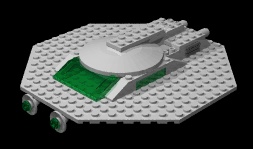
|
UX-1 Arilou |
|
NOT COMPLETE YET! I still need to add the laser cannon and fix a few other things in the .dat file, but here is a general idea of the Arilou. More views will be up shortly! Inspired by the Arilou from the video game "Star Control", the Arilou is a mysterious flying saucer that defies most of the central laws of physics. It is equipped with a Zero-Inertia Drive system, which allows it to accellerate instantaneosly, as well as letting it ignore any and all forces attempting to act upon it. All that is known about this system is that it somehow completely nullifies the Arilou's mass, allowing it to perform the bizarre assortment of meneuvers it is famous for. A favorite tactic of Arilou pilots is to approach a nearby blackhole or other massive body, and dare their attacker to step too close. As if the Zero-Inertia system weren't enough, the Arilou is also equipped with a powerful, albeit, unpredictable, hyperdrive. Arilou's have vanished from radar screens only to reappear instantly half a lightyear away. It is assumed that the beings who designed the Arilou intended for this technology to be used as a last ditch effort, since the saucers apparently cannot control where they go when the hyperdrive is activated. A few unfortunate Arilou pilots have lost their lives by rematerializing too close to stars or even inside of planets. The Arilou is armed solely with a small, belly mounted pulse laser on a turret. The weapon has automatic aim, but fairly short range. When the attacker gets close enough, this small weapon can inflict significant, but not devastating damage. Experienced Arilou pilots do not try to destroy their enemy, rather, they try to make their enemy destroy himself or give up. |
||
Propulsion
|
Armament
|
Designed and Built
|
I-109
|
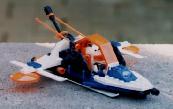
|
I-109 Starling |
|
The Starling is a light recon craft armed solely with a rear mounted laser cannon. Its two passengers are seated back to back with the gunner facing aft to give any would-be attackers the not-so subtle message of "don't follow me." It is lightly armed, lightly shielded, and is never known to attack head on. Its main power is in its high speed and agility. |
||
Propulsion
|
Armament
|
Designed and Built
|
PF-51A
|
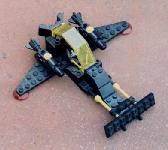
|
PF-51A Sparrow Killer |
|
The Sparrow Killer is another revision of the immortal Alienator. My design is related to one of the alternate models on the box, but I've swapped a few things here and there. As the story goes, the first allied fighter to ever meet up with this craft saw it, laughed, and jokingly called it a "sparrow killer". His atoms were soon recycled by the new Blacktron fighter's anti-matter ejection cannons, but the name stuck... This fighter was originally designed as a counter to the allied forces' smaller spacecraft. However, it packs enough of a punch to take on spacecraft considerably larger than it. Its primary weapons system is made up of two anti-matter cannons. Each cannon fires a dense ball of anti-matter at high velocity using an electro-magnetic propulsion system. The SK is also, of course, equipped with the standard Blacktron Cloaking system. |
||
Propulsion
|
Armament
|
Designed and Built
|
X-89
|
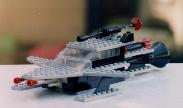
|
X-89 Raven |
|
I designed this one way back in 5th grade (about 1988) while at daycamp. I was so proud of it that I asked the counselor to save it for me so that the next day, I could bring my camera and take a picture of it. Once I got my photos developed I built it again--this time using my own pieces. Needless to say, the influence classic space has had on me is apparent in this model. |
||
Propulsion
|
Armament
|
Designed and Built
|
Links
-- Home Page -- Building Tips -- POV Ray Color Tweaks --